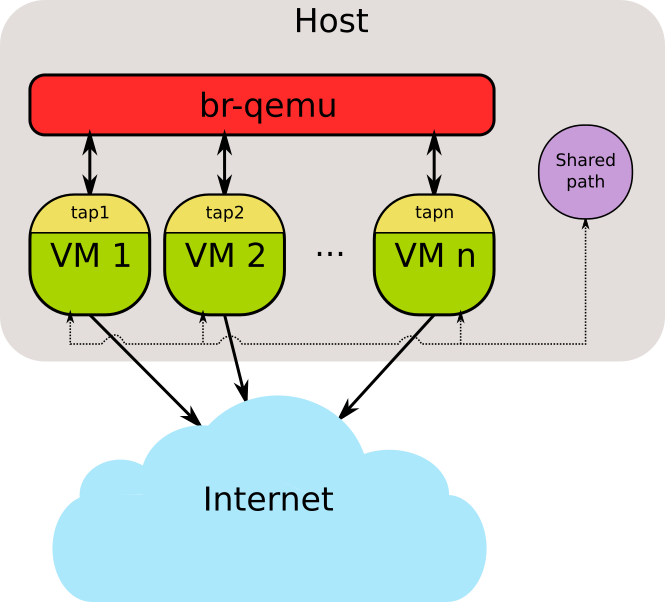

 Luminary Micro LM3S6965EVB (ARM Cortex-M3). Luminary Micro LM3S811EVB (ARM Cortex-M3). Spitz, Akita, Borzoi, Terrier and Tosa PDAs (PXA270 processor). ARM RealView Emulation/Platform baseboard (ARM). Malta board (32-bit and 64-bit MIPS processors). Sun4u/Sun4v (64-bit Sparc processor, in progress). Sun4m/Sun4c/Sun4d (32-bit Sparc processor). Mac99 PowerMac (PowerPC processor, in progress). QEMU can run without a host kernel driver and yet gives acceptableįor system emulation, the following hardware targets are supported: To ease cross-compilation and cross-debugging. Launch the Wine Windows API emulator ( ) or Processes compiled for one CPU on another CPU. Without rebooting the PC or to debug system code. It can be used to launch different Operating Systems In this mode, QEMU emulates a full system (forĮxample a PC), including one or several processors and various QEMU is a FAST! processor emulator using dynamic translation to 6.3 Cross compilation for Windows with Linux. 4 QEMU System emulator for non PC targets. 3.13.2.5 Share a directory between Unix and Windows. 3.13.2.3 Windows 2000 disk full problem. 3.11.8.1 Setup the Certificate Authority. 3.11.7 With x509 certificates and SASL authentication. 3.11.5 With x509 certificates, client verification and passwords. 3.11.4 With x509 certificates and client verification. 3.10.2 Using host USB devices on a Linux host. 3.7.4 Connecting VLANs between QEMU instances. 3.7.3 Using the user mode network stack. 3.6.1 Quick start for disk image creation. We also need to set polkit (policy kit) rules for KVM.Įdit file les: ~]# vim /etc/polkit-1/rules.d/lesĪnd add the following ath the bottom: polkit. We need to add our regular user tuxfixer to kvm group to let him launch virt-manager ~]# usermod -a -G kvm tuxfixer Launch and enable libvirtd daemon ~]# systemctl enable ~]# systemctl start libvirtd
Luminary Micro LM3S6965EVB (ARM Cortex-M3). Luminary Micro LM3S811EVB (ARM Cortex-M3). Spitz, Akita, Borzoi, Terrier and Tosa PDAs (PXA270 processor). ARM RealView Emulation/Platform baseboard (ARM). Malta board (32-bit and 64-bit MIPS processors). Sun4u/Sun4v (64-bit Sparc processor, in progress). Sun4m/Sun4c/Sun4d (32-bit Sparc processor). Mac99 PowerMac (PowerPC processor, in progress). QEMU can run without a host kernel driver and yet gives acceptableįor system emulation, the following hardware targets are supported: To ease cross-compilation and cross-debugging. Launch the Wine Windows API emulator ( ) or Processes compiled for one CPU on another CPU. Without rebooting the PC or to debug system code. It can be used to launch different Operating Systems In this mode, QEMU emulates a full system (forĮxample a PC), including one or several processors and various QEMU is a FAST! processor emulator using dynamic translation to 6.3 Cross compilation for Windows with Linux. 4 QEMU System emulator for non PC targets. 3.13.2.5 Share a directory between Unix and Windows. 3.13.2.3 Windows 2000 disk full problem. 3.11.8.1 Setup the Certificate Authority. 3.11.7 With x509 certificates and SASL authentication. 3.11.5 With x509 certificates, client verification and passwords. 3.11.4 With x509 certificates and client verification. 3.10.2 Using host USB devices on a Linux host. 3.7.4 Connecting VLANs between QEMU instances. 3.7.3 Using the user mode network stack. 3.6.1 Quick start for disk image creation. We also need to set polkit (policy kit) rules for KVM.Įdit file les: ~]# vim /etc/polkit-1/rules.d/lesĪnd add the following ath the bottom: polkit. We need to add our regular user tuxfixer to kvm group to let him launch virt-manager ~]# usermod -a -G kvm tuxfixer Launch and enable libvirtd daemon ~]# systemctl enable ~]# systemctl start libvirtd 
Install KVM related packages ~]# yum install qemu-kvm qemu-img libvirt libvirt-python libvirt-client virt-install virt-viewer virt-managerĤ. Removed symlink /etc/systemd/system//rvice. NetworkManager is known to cause problems when working with Linux Bridge, so for us it’s better to disable it: ~]# systemctl stop ~]# systemctl disable NetworkManager Model name: Intel(R) Core(TM) i5-2520M CPU 2.50GHz Our CPU must support hardware virtualization ( VT-x) in order to become KVM Hypervisor and host Virtual Machines (guest operating systems): ~]# lscpu Verify CPU Hardware Virtualization support The below tutorial presents KVM (QEMU) installation and setup along with Linux Bridge configuration on CentOS7 / RedHat7 operating system.ġ. KVM is convenient solution to test and try different operating systems if you don’t have a possibility to purchase expensive and power consuming physical hardware. KVM (Kernel-based Virtual Machine) is a virtualization infrastructure for the Linux which requires a processor with hardware virtualization extension to be able to host guest sytems.







 0 kommentar(er)
0 kommentar(er)
